Waking the Dead - – Did Jesus really "raise" anyone?
Of the 35 miracles supposedly performed by Jesus three were nothing less than restoring life to the recently dead. The lucky three were, implicitly, returned to normal life and would die another day, though we are told nothing of their post death adventures. Perhaps like Tom Hanks in The Green Mile they lived to a quite extraordinary age? Yet we can be reasonably certain the three were not “resurrected” to life eternal in a supernatural body in the manner of JC himself. That cachet was for JC alone.
But were the three ever raised at all?
Outwitting the Grim Reaper – Luke's tale
The son of the Widow of Nain
The Hill of Moreh lies at the eastern end of the Jezreel plain. On its southwestern slope once stood the town of Shunem. It was here that the Old Testament prophet Elisha restored to life a woman’s dead son. On the northern slopes of the same hill, about a mile away, stood the town of Nain. And it was here, according to the writer of Luke (though no one else), that Jesus Christ performed exactly the same trick.* To the rational mind, the Christian fable merely copies the Old Testament tale, ensuring that the new hero JC meets and exceeds the power of the earlier prophet. To the pious mind, the rehashed yarn achieves “fulfilment” in Christ.
Elisha’s miracle is itself a reprise of a stunt performed by his mentor Elijah. In the “original” story, Elijah is hiding from King Ahab somewhere near Sidon. He is fed by a poor widow who is under “God’s command” and miraculously her barrel of meal never runs out. But her son dies, and this affords Elijah an opportunity to restore him to life.
“And when he came to the gate of the city, behold, the widow woman was there gathering of sticks … And it came to pass after these things, that the son of the woman, the mistress of the house, fell sick … there was no breath left in him … And he stretched himself upon the child three times, and cried unto the LORD … and the soul of the child came into him again, and he revived. And Elijah took the child … and delivered him unto his mother.”
– 1 Kings 17.10,23.
In the updated Elisha version, the scene is transferred from Phoenicia to Galilee and the story is broken into two parts. In the first part a poor widow is rewarded with the multiplication of food miracle (this time it’s oil). In the second part a childless woman is granted a child who, as a boy, inexplicably dies. Again, this presents an opportunity for a restoration of life miracle and Elisha, like Elijah, lays upon the child and breathes new life into him.
“And when Elisha was come into the house, behold, the child was dead, and laid upon his bed … And he went up, and lay upon the child, and put his mouth upon his mouth, and his eyes upon his eyes, and his hands upon his hands: and stretched himself upon the child; and the flesh of the child waxed warm. Then he returned, and walked in the house to and fro; and went up, and stretched himself upon him: and the child sneezed seven times, and the child opened his eyes. … And when she was come in unto him, he said, Take up thy son.”
– 2 Kings 4.32,36.
In Luke’s version of the same story there are, it seems, “original” elements, as well as the repeated motifs of “location”, “widow” and “only son”. JC meets the funeral procession on its way to the grave. Crying is mentioned and Jesus does not lie on the corpse but rather touches the burial casket and speaks to the body.
“Now when he came nigh to the gate of the city, behold, there was a dead man carried out, the only son of his mother, and she was a widow: and much people of the city was with her. And when the Lord saw her, he had compassion on her, and said unto her, Weep not. And he came and touched the bier: and they that bare him stood still. And he said, Young man, I say unto thee, Arise. And he that was dead sat up, and began to speak. And he delivered him to his mother.”
– Luke 7.12,15.
Historically authentic? Hardly. Consider the evidence from another funeral and another wonder-worker, Apollonius of Tyana.
“A girl had died just in the hour of her marriage, and the bridegroom was following her bier lamenting as was natural his marriage left unfulfilled, and the whole of Rome was mourning for him, for the maiden belonged to a consular family. Apollonius then, witnessing their grief, said: “Put down the bier, for I will stay the tears that you are shedding for this maiden”. And withal he asked what was her name …
Merely touching her and whispering in secret some spell over her, he at once woke up the maiden from her seeming death , and the girl spoke out loud and returned to her father’s house, just as Alcestis did when she was brought back to life by Hercules.”
– Flavius Philostratus, Vita Apollonii, 4.45.
Note that Philostratus’ report of the 1st century Apollonius “raising the dead” refers back to an even earlier Greek myth (Euripides Alcestis) told of another demigod, Hercules!
In other words, in the Lucan tale we have not “history” but a classical “raising the dead” yarn which adapts elements of Greek myth to Jewish prototypes, filtered through a story told about a Pythagorean sage! We might also note that not only is “Luke” the sole gospel writer to mention the Widow of Nain tale but that “Luke” was the supposedly part-time travelling companion of Paul and certainly no “eye-witness” of Jesus.
Outwitting the Grim Reaper – John's tale
The Raising of Lazarus
“The name Lazarus, in the same abbreviated form La’zar (for El’azar, Eleazar) which we find in the Gospels, is quite common on the ossuaries.”
– W. F. Albright, The Archaeology of Palestine, p244.
The most famous of JC’s “raisings” is the one reported by John. It is the most detailed and dramatic – which makes it all the more curious that it goes unrecorded in any of the synoptic gospels. But then, in a sense, it does appear, not as a miracle but as parable. A complex web is woven in which the threads are a place (Bethany), two sisters (Mary and Martha), a Simon, a jar of expensive ointment, Jesus’ feet, a corpse and a return to life.
Early in Luke, after the incident at Nain and an exchange of messages with John the Baptist, Simon the Pharisee invites Jesus to dinner. As he eats, an unnamed prostitute “stood at his feet behind him” (!) and in some curious contortion manages to wash his feet with her tears, wipe them with her hair, and anoint them with ointment from an alabaster box. JC uses the occasion to pontificate on degrees of sin and love. (Luke 7.36,40).
A little later in Luke, JC finds himself in “a certain village” with “a certain woman” named Martha and a sister called Mary. To Martha’s chagrin, Mary, rather than help with the dishes, “sat at Jesus’ feet” to hear his words. The great man tells Martha to chill out, or words to that effect, declaring that Mary’s action is “the good part”. (Luke 10.38,42).
Luke’s final contribution comes in chapter 16. JC has wended his way “through the cities and villages towards Jerusalem”, telling a multitude of parables. One of the last he relates is the story of “a certain rich man” and a sick beggar called Lazarus, who has fed on crumbs from the rich man’s table. Both die, the beggar taken up to heaven, the rich man down to hell. The pleas from the rich man for Lazarus to cool his thirst are in vain. It’s payback time. The crunch line is delivered by JC:
“If they hear not Moses and the prophets, neither will they be persuaded, though one rose from the dead.”
– Luke 16.19,31.
In these words Jesus mouths a rebuttal to any suggestion that a reanimated corpse might be a good way to convince unbelievers of his mighty power. Belief must come from scripture, not physical evidence. This rather nicely gets the priests out of a hole. Luke’s parable is the only reference to a Lazarus in any of the synoptic gospels and there is no suggestion that the two sisters might have a brother of that name.
Matthew (and Mark) conflate Luke’s first two stories into one. The village is now named as Bethany and the house is that of Simon the Leper. As Jesus eats, an unnamed woman anoints his head by pouring “very precious ointment” from an alabaster box. The disciples protest at the waste (not to mention the mess) but JC declares that the woman has “wrought a good work”. (Matthew 26.3,13; Mark 14.1,9).
John’s gospel now completes the wondrous yarn by weaving all three of Luke’s tales into one. Lazarus is no longer the hero of a parable but is the flesh-and-blood brother of Martha and Mary. The opening verses of chapter 11 make clear that the unnamed prostitute with such versatile hair that featured in Luke 7 in fact is Mary of Bethany.
“Now a certain man was sick, named Lazarus, of Bethany, the town of Mary and her sister Martha. It was that Mary which anointed the Lord with ointment, and wiped his feet with her hair, whose brother Lazarus was sick.”
– John 11.1,2.
The sisters have not hitherto been mentioned in John so clearly the writer is working from the other gospels. Apparently, Jesus loves the whole family (note the emphasis – but doesn’t he love everybody?) – Lazarus “he whom thou lovest”, Martha and her sister “Jesus loved”. The sisters “sent unto him” (does everybody have a servant?) but Jesus dallies. It seems he already knows Lazarus is sick but is unconcerned, events will all reflect “to his glory”:
“When Jesus heard that, he said, This sickness is not unto death, but for the glory of God, that the Son of God might be glorified thereby.”
– John 11.4.
Where exactly is Jesus at this point? He has “escaped” out of Jerusalem and is beyond the Jordan “where John first baptized.” John says in 1.28 that this is “Bethabara” but no such place is known to history. Many Bibles “correct” this (confusingly) to read Bethany to flow with the following verses (well, it is all a fiction, after all!). After an affected delay Jesus deigns to visit his now dead friend, in his grave four days and “stinking”. The motif of “four days” is chosen in deference to the Jewish notion that the soul hovers at the grave for three days. Lazarus is really dead.
Martha goes out to meet the approaching holy man and affirms her faith in both resurrection “at the last day” and Jesus as the Son of God. Inexplicitly Jesus again dallies, this time allowing Martha to “secretly” tell her sister Mary that “the Master” has called for her. Mary rushes out to fall at JC’s feet (love those feet!) and Jesus, who knows everything, asks where Lazarus is buried. The crowd of Jews who have gathered in sympathy question whether Jesus could have saved the life of his “loved friend” (the one that we have never heard of before). Jesus groans and weeps.
At the cave where Lazarus is buried Jesus orders the removal of the stone door and very publicly prays, explaining his motive for this to God himself (who surely knows everything?).
“Father, I thank thee that thou hast heard me. And I knew that thou hearest me always: but because of the people which stand by I said it, that they may believe that thou hast sent me.”
– John 11.41,42.
Finally, Jesus shouts “Lazarus, come out!” and the dead man emerges, grave clothes and all.
At this point, “Lazarus”, loved friend and restored dead man, is all but entirely dropped from the story (what? no tales from the grave?). Instead, John’s focus is back on JC and a repeat of the “costly ointment/hair wiping feet” scene from the synoptic gospels referred to briefly at verse 11.2. History is about to repeat itself.
But there is no possibility this could be a a second, similar instance. John picks up the precise value of the ointment (“spikenard”) used at Mark 14.4 (“three hundred pence”). John reiterates identical Jesus dialogue to justify his indulgence of costly ointment “because the poor are always with you”. And John has Jesus issue the same instruction to his disciples to “Let her alone!” The only difference is that John has shifted the indignation of the disciples (Matthew 26.8, Mark 14.4) to one disciple alone. Judas Iscariot, son of Simon (the Pharisee or is that the Leper?!) has been fingered as the bad guy.
“Then took Mary a pound of ointment of spikenard, very costly, and anointed the feet of Jesus, and wiped his feet with her hair: and the house was filled with the odour of the ointment. Then saith one of his disciples, Judas Iscariot, Simon’s son, which should betray him, Why was not this ointment sold for three hundred pence, and given to the poor? This he said, not that he cared for the poor; but because he was a thief, and had the bag, and bare what was put therein. Then said Jesus, Let her alone: against the day of my burying hath she kept this.”
– John 12.3,7.
What are we to make of a “historical” event that both begins and ends at the same moment in “history”, a pastiche of borrowed elements and recycled names? The answer is NO HISTORY AT ALL. The “raising of Lazarus” is as bogus as the flying pigs of Gadara and the birthing of a god from a Jewish virgin. The rehashed story does not even have its origins with fiction from the synoptic gospels but rather with a rabbinic tale of Bar Majan the tax collector, itself copied from Egyptian funeral texts of El-Azar, an ancient prototype for the Lazarus parable of judgement in the afterlife.
But then, why waste a good yarn?
Outwitting the Grim Reaper – Jairus' daughter
All three synoptic gospels tell the story of a 12-year-old girl who had died in her bed and was visited by Jesus. The child it seems was the daughter of “a ruler of the synagogue” called Jairus. Jesus took hold of the girl’s hand and told her to get up. That’s all it took to return the girl to life. One presumes that the dire malady which had caused her premature death had been cured at the same time and the girl didn’t just die the next day!
A simple tale, which, significantly, in each gospel is interrupted by a second story, of a woman having a 12-year issue of blood, who is cured by touching JC’s garment, “cured by faith”. Note the contrast: JC’s healing hands perform miracles but so does faith in the Lord. The message is clear: don’t expect miracles, your faith will cure you.
Who were the witnesses to this little drama of outwitting the grim reaper? Mark tells us it was three disciples and the parents:
“And he suffered no man to follow him, save Peter, and James, and John the brother of James … And they laughed him to scorn. But when he had put them all out, he taketh the father and the mother of the damsel, and them that were with him, and entereth in where the damsel was lying.”
– Mark 5.37,40.
Luke agrees:
“And when he came into the house, he suffered no man to go in, save Peter, and James, and John, and the father and the mother of the maiden.”
– Luke 8.51.
What pulls the carpet from under this shaggy-dog story is that only one of the witnesses wrote a testimony – John – and he says not a word about it! Perhaps that is why both Mark and Luke add that JC’s performance was kept secret: “He charged them straitly that no man should know it” – Mark 5.43; “He charged them that they should tell no man” – Luke 8.56. Unfortunately this instruction does not seem to have reached the ears of Matthew. This evangelist reports the exact opposite:
“The fame here of went abroad into all that land.”
– Matthew 9.26.
What we have here, then, is not eye-witness testimony to a reality but inconsistent “testimony” from non-witnesses. Their tale is especially suspect because it is not confirmed by the only purported “witness” to the drama. As Robert Price suggests, “We ought to catch the hint that it is fictional, as the name ‘Jairus’ means ‘He will awaken.”! (The Incredible Shrinking Son of Man, p152) It is also possible that the evangelists were browsing through their well-thumbed copy of Josephus for good ideas.
Outwitting the Grim Reaper – Matthew's Tale
When the Saints come marching in
“Jesus, when he had cried again with a loud voice, yielded up the ghost. And, behold, the veil of the temple was rent in twain from the top to the bottom; and the earth did quake, and the rocks rent;
And the graves were opened; and many bodies of the saints which slept arose, And came out of the graves after his resurrection, and went into the holy city, and appeared unto many.”
– Matthew 27.50,53.
This primitive piece of holy moonshine did not really make it into “mainstream” Christianity. It’s there in Matthew (and gains some support in the so-called epistles of Ignatius) but the other gospellers prudently avoid repeating such nonsense. If they had, we would surely be entertained by apologists claiming that this mass rising had really happened and that it represented “fulfilled prophecy”: the verses in Matthew are a crib from the soothsayer Zechariah, complete with “earthquake cleaving the Mount of Olives” and the dead saints rising and repopulating Jerusalem.
“Behold, the day of the LORD cometh … And his feet shall stand in that day upon the Mount of Olives, which is before Jerusalem on the east, and the Mount of Olives shall cleave in the midst thereof toward the east and toward the west, and there shall be a very great valley; and half of the mountain shall remove toward the north, and half of it toward the south … ye shall flee, like as ye fled from before the earthquake in the days of Uzziah king of Judah: and the LORD my God shall come, and all the saints with thee.”
– Zechariah 14.1,5
The three orphaned verses of Matthew are the residue of this very early notion that cosmic upheaval would accompany the coming of the Messiah. The chronology is uncertain but implicitly judgement day has begun, and with it the separation of the righteous from the godless.
But the melodrama has an obvious basis in the mundane. Separating the old walled city of Jerusalem from Mount Olivet to the east is a depression which has been known variously as the Valley of Jehoshaphat, Wadi en Nar (Valley of Fire) and the Kidron Valley. Its extension running immediately south west of the old city was the Valley of Hinnom, which originally enjoyed the name Gehenna. It was here that ritualistic burning of human sacrifices occurred (well, according to Jeremiah and 2 Chronicles, that is). No doubt the real burning of enemies led to the prophetic notion that on the Day of the Lord faithful Jews would gloat on the godless in torment below from the sanctuary of their holy mountain.
“Then Uriel, one of the holy angels who were with me, replied, This valley is the accursed of the accursed for ever. Here shall be collected all who utter with their mouths unbecoming language against God, and speak harsh things of His glory. Here shall they be collected. Here shall be their territory.”
– 1 Enoch 26.2.
Gehenna superceded the older (and less terrifying) Sheol as the underworld of the Jews and would in time become the Hell so beloved by the Christians. In a “first draft” for the End Time, their Messiah’s arrival would signal a general resurrection of the saints who would emerge from the graves of Mount Olivet. The entire apocalyptic landscape of Judgement, Heaven and Hell reflects nothing other than the localized topography of the hills and valleys of Jerusalem!
The “loose end” of many walking dead in Matthew led the other evangelists to adopt an alternative scenario that JC was the “first fruit” of resurrection and that the “general resurrection” would have to wait.
Smart move, or everyone might have asked, What happened to those raised saints strolling about Jerusalem?
End of Days
We will never know if there will ever be a Last Day and a general Resurrection of the Dead.
To those of simple minds and naive faith it is as certain as their morning coffee and a walk in the park. But for more sober minds, judging the promise of a “life to come” on the strength of the purported life-restoring miracles of Jesus of Nazareth, the prospect does not look particularly bright. If, as is certain, they are all literary frauds, designed to impress the credulous and strengthen faith in “scripture”, what chance then that the purported Resurrection of the Lord is any less bogus?
Sources:
- Robert M. Price, Jeffery Jay Lowder,The Empty Tomb: Jesus Beyond The Grave (Prometheus 2005)
- Robert M. Price, The Incredible Shrinking Son of Man (Prometheus 2003)
- Thomas L. Thompson, The Messiah Myth (Jonathan Cape, 2006)
- M. Black, H. Rowley (Eds) Peake’s Commentary on the Bible (Nelson, 1964)
- John Dominic Crossan, The Historical Jesus (Clark, 1991)
- Gary Habermas, The Verdict of History (Monarch, 1990)
Related Articles:
“Best attested event in ancient history” or utter baloney?
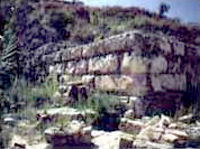
Dawn of the Dead?
“And the graves were opened; and many bodies of the saints which slept arose,”
– Matthew 27.50.
Not a verse that gets much attention from the “historical Jesus” school.
Ancient Jewish lore said that the Lord would split open Mount Olivet and the righteous dead would rise.
This scenario crept into Matthew 27 but the other evangelists prudently ignored this challenging “historical event”.
Miracle at Nain?
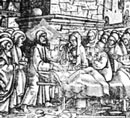
In the Christian dreamscape, JC raises a widow's son. What perhaps should ring alarm bells is that this story had been used before – repeatedly!
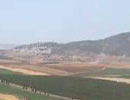
Hill of Moreh, south side (Shunem). Elisha raises the dead son – the only child – of an old woman (2 Kings 4.32,35).
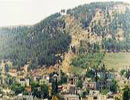
Hill of Moreh, north side (Nain). Jesus raises the dead son – the only child – of an old woman (Luke 7.11,15).
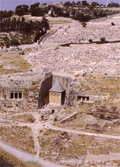
Tombs R Us
A view looking across the Kidron Valley from Temple Mount to the Mount of Olives. The hillside is a vast cemetery, complete with many elaborate tombs.
Lazarus, come forth! Tourists, this way!
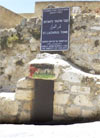
Bethany, (on the eastern slope of Mount Olivet, a little over a mile from the Old City of Jerusalem) has a suitable "Lazarus tomb" to attract the tourists. This "tomb entrance" was built by Franciscan monks at the end of the 16th century.
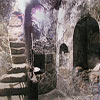
Steps lead down to a large ante-chamber, modified by crusaders.
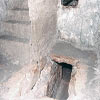
The tomb of Lazarus – well someone's tomb.
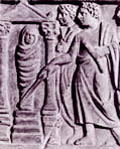
Tomb Raider
Notice that the Lazarus “tomb” depiction on this 3rd century sarcophagus features an Hellenic style tomb and a corpse wrapped in the style of an Egyptian mummy – not what might be expected for a Judaean peasant (and not exactly the Turin shroud!).
Jesus, in Roman toga, waves his magic augur’s wand.
History or myth?
Josephus' "Lazarus" rescued from "death"
“There was a certain young man among the besieged, of great boldness … his name was Eleazar … Now a certain person belonging to the Roman camp … ran upon him suddenly, when nobody expected such a thing, and carried him off …
So the general of the Romans ordered that he should be taken up naked, set before the city to be seen, and sorely whipped before their eyes. … he commanded them to set up a cross, as if he were just going to hang Eleazar upon it immediately;
So the general of the Romans ordered that he should be taken up naked, set before the city to be seen, and sorely whipped before their eyes. … he commanded them to set up a cross, as if he were just going to hang Eleazar upon it immediately;
– Josephus, War 7.6.4.
"Jairus" in Josephus
Three times Josephus mentions a “Jairus”, in each instant as the father of a protagonist:
“A few there escaped to Masada, among whom was Eleazar, the son of Jairus, who was of kin to Manahem, and acted the part of a tyrant at Masada afterward.” – Wars 2.17.9.
“Those that … fought most zealously … the zealots, two brethren, Simon and Judas, the sons of Jairus.” – Wars 6.1.8.
“Not one of the Jews escaped out of this battle, but they were all killed, being in the whole not fewer in number than three thousand, together with Judas, the son of Jairus, their general, concerning whom we have before spoken, that he had been a captain of a certain band at the siege of Jerusalem, and by going down into a certain vault underground, had privately made his escape.” – Wars 7.6.5.
It is in the next paragraph that Josephus mentions Emmaus! The reference to escape from an underground vault has an intriguing connection with a “resurrection” ruse attempted by “Simon the Tyrant”:
“Simon … let himself and all them down into a certain subterraneous cavern that was not visible above ground.
And now Simon, thinking he might be able to astonish and elude the Romans, put on a white frock, and buttoned upon him a purple cloak, and appeared out of the ground in the place where the temple had formerly been. At the first, indeed, those that saw him were greatly astonished.”
– Wars 7.2.1.

Where did they go?
Brick Testament Laugh or cry?
The writer of Ignatius’ epistle to the Magnesians was one of the few who liked the idea of the dead rising from their graves:
“For the prophets also became His disciples, and awaited in the Spirit His coming to teach them. And therefore He, for Whom they rightly waited, came and raised them from the dead.” – Ignatius, Magnesians 9.
Odd Roman
* The Widow of Nain story follows the Sermon on the Mount and JC’s encounter at Capernaum with a most peculiar Roman centurion – “a lover of the Jews … who built a synagogue” (Luke 7.5).
The man turns out to have more faith in Jesus “than any in Israel”!
Did the local Prefect know about this? Such an odd Roman officer raises more questions than it answers!
At the beginning of the 20th century Gerald Massey explored exhaustively the dependence of biblical tales on Egyptian mythos.
According to Massey, two divine sisters, Isis and Nephthys – the ‘Mary and Martha’ of Beth-Annu – watched over the tomb of Osiris.
Horus raised Osiris (‘El-Osiris’) by calling his mummy forth to assume the likeness of Ra the Holy Spirit.
